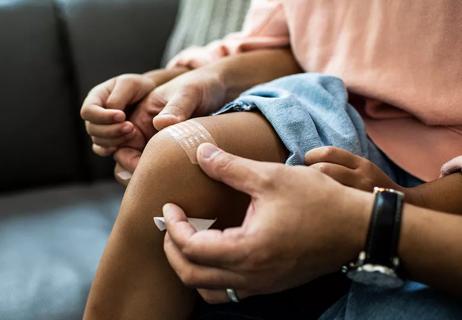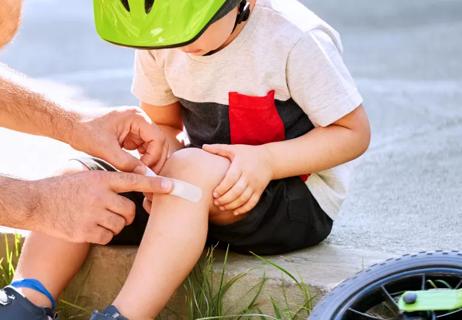If the area is bleeding a lot or the wound is near your face or genitals, you likely need a specialist’s care

Many minor cuts and lacerations heal without medical intervention. But some injuries need treatment, like stitches, to ensure proper healing. And that means a trip to urgent care or, sometimes, the ER.
Advertisement
Cleveland Clinic is a non-profit academic medical center. Advertising on our site helps support our mission. We do not endorse non-Cleveland Clinic products or services. Policy
So, how do you know if you need stitches? Pediatric emergency medicine physician Purva Grover, MD, offers guidance on when to visit an urgent care or the ER for a cut, and what qualifies a wound for stitches.
Certain lacerations almost always require a visit to the ER or urgent care center for stitches. Here are some of the ways Dr. Grover determines whether a wound needs stitching.
If your wound is deep enough to expose your dermis (the middle layer of your skin) or you can see the yellow, fatty tissue underneath your dermis (subcutaneous fat), you need immediate medical attention and, likely, stitches.
Healthcare providers have the tools and training needed to address deep cuts. In addition to stopping the bleeding and closing the wound, they may:
If your cut is gaping open — meaning you need more than gentle pressure to press the edges together — it’ll need stitches or some other kind of medical intervention, like surgical staples.
Advertisement
Some wounds need to be closed at multiple levels. That process usually happens in surgery. The surgeons use dissolvable stitches to repair wounds deeper down in your body and slowly work their way up. This reduces the gaping and tension for easier wound closure.
If you put direct pressure on your wound for 10 or 15 minutes and it hasn’t stopped bleeding or slowed considerably, it’s time to go to an urgent care or ER.
If blood is spurting out of your wound, call 911 or emergency services immediately. This kind of bleeding can be life-threatening. Emergency medical technicians (EMTs) have medications, specialized equipment and wound dressings in the ambulance that can help stop the bleeding and encourage clotting.
“If you come to the ER or call emergency services about bleeding, tell them if you’re taking blood thinners,” Dr. Grover stresses. “That information can change your treatment plan. You may need medication or a more advanced wound-closure technique to stop the bleeding, for example.”
Once providers have stopped the bleeding, they can stitch, glue or staple the laceration closed.
If your cut is on or directly impacts one of your joints, it will probably need stitches, and may need to be checked by a specialist to rule out nerve, tendon or ligament damage. Depending on the location and severity of your injury, the joint may also need to be immobilized in a splint. That will keep you from bending the joint and popping the stitches.
If an animal or human bit you badly enough to draw blood, seek medical attention immediately. You may need stitches. Dr. Grover says your physician may also prescribe oral antibiotics to prevent infection.
Adults who haven’t had a tetanus booster shot within the past 10 years will be encouraged (but not forced) to get one. Ditto for children who haven’t had the vaccine yet.
It’s a natural impulse, but don’t remove a foreign object — like a piece of wood or metal — that’s stuck in your wound. Go straight to the ER.
“You don’t know what’s been struck,” Dr. Grover states. “More than once, I’ve seen cases where the object struck an artery and was blocking the bleeding. In those cases, pulling it would have meant uncontrolled bleeding, which can have devastating consequences.”
If you have an open wound because something struck you hard and fast, you need to have it examined at an ER or an urgent care center. Here are a few examples that fit the bill:
If your injury got dirty or a rusty object caused it, it needs medical attention. The staff at the ER or urgent care will clean the wound and remove any debris before stitching up your wound. You may also be offered a tetanus shot, antibiotics or both.
Advertisement
If the injury is in an area that could significantly affect your appearance — like your face — Dr. Grover recommends going to the ER for stitches. Depending on the severity of the wound and where it’s located, it may need evaluation and treatment by a plastic surgeon.
If you have a bleeding wound on or near your genital area, it’s important to go to an ER or urgent care.
Your kidneys, bladder, intestines, colon and reproductive organs are complex and sensitive bits of equipment. Injuries in these areas tend to bleed heavily. And they have to heal in an environment that’s darker, warmer and wetter than most of your body. And — as these organs are all squished together in your lower abdomen — it’s easy to injure several at once, without even realizing it.
When you have a bleeding injury to your genital region, there’s also a high risk of infection and other complications, including:
When it comes to open wounds on or near your genitals, it’s better to be safe than sorry.
Whether you’re on your way to the hospital for stitches or you’re trying to figure out if you should be, there are a few things you should know about caring for cuts. Dr. Grover offers the following tips.
Advertisement
Advertisement
If you’re waffling about going to the ER or urgent care, you’re probably asking yourself: How long after a cut is too late for stitches? Unfortunately, the window is pretty short — about 24 hours. While you can technically get stitches over a day later, they aren’t going to be as effective.
But what happens if you don’t get stitches at all? The answer depends on how serious your injury is, but generally, not getting stitches when you need them can:
The good news? You don’t have to make this decision alone. You can always call your primary care provider — or if they’re closed, an urgent care center — for advice. They can help make sure that you get patched up properly.
Learn more about our editorial process.
Advertisement

First, assess the seriousness of the wound, and then apply light pressure to stop any bleeding

Clean hands, sanitized tweezers and a soaking tub are key to removing some shards of glass

The best tools and practices from a pediatrician

Quick action and proper care can make a big difference

The short answer from a plastic surgeon

Three common causes of chronic wounds

Lots of things can activate the herpes simplex virus, from the common cold and cold weather to cracked skin and cosmetic procedures

Honey can help make a sore throat more bearable by tamping down inflammation and coating your throat

Start having sex about 72 hours before ovulation, then at least every other day during your fertile window

Attachment theory suggests that your earliest relationships shape connections throughout your life

It isn’t a recognized mental health disorder, but research shows that problematic social media use can negatively affect your mental health, self-esteem and sleep